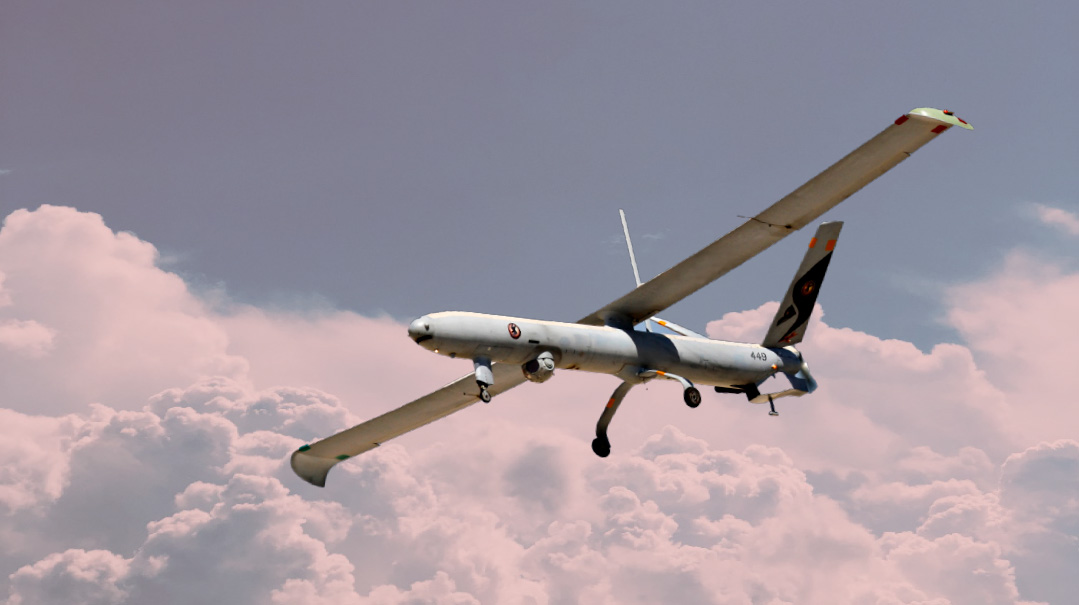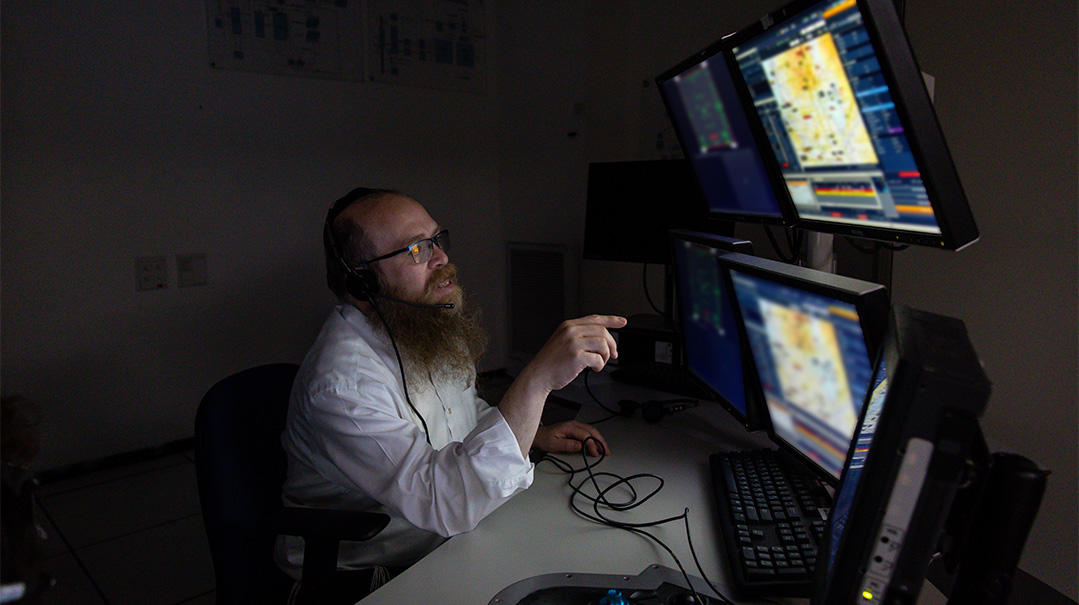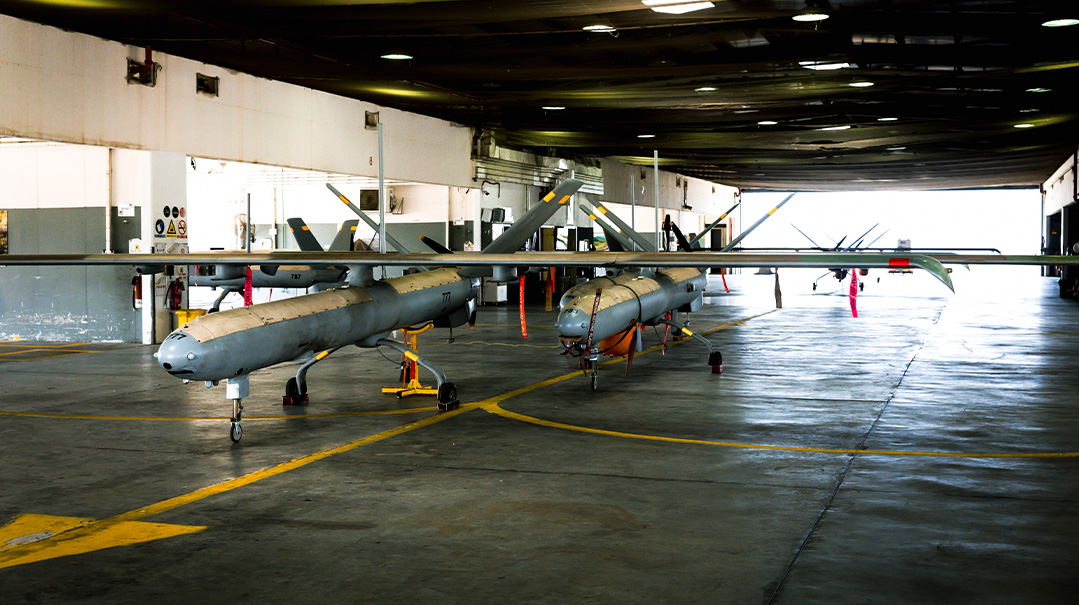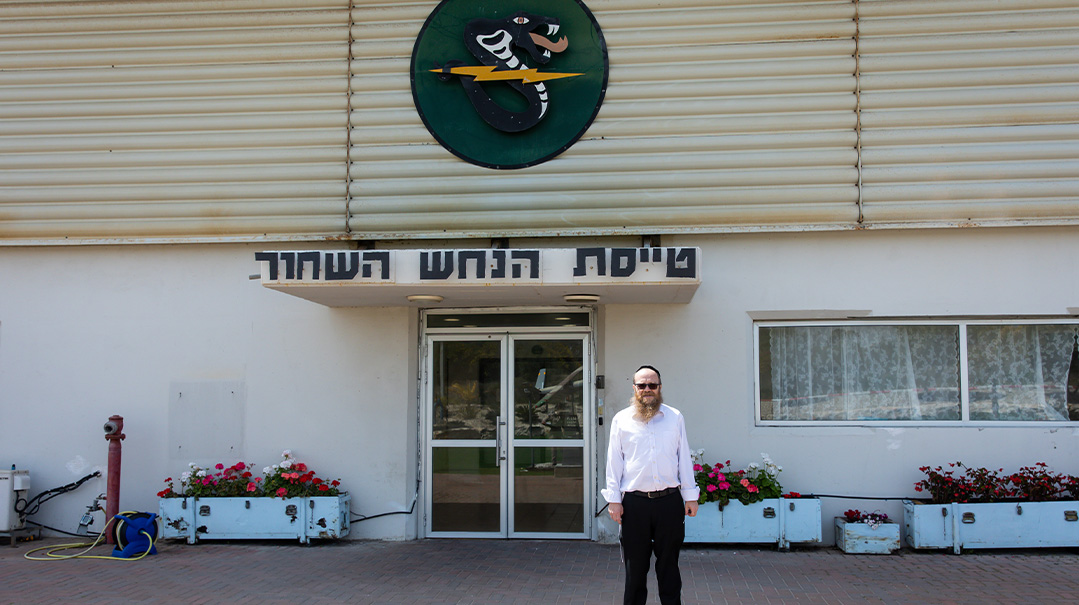Eye in the Sky

Eliezer Shulman reports from the control room of Israel's deskbound pilots

Fifty years after Israel pioneered drone deployment in combat, the country’s UAV fleet operates round-the-clock collecting intelligence and performing surgical strikes far beyond Israel’s shores.
For half a year, terrorists planned an attack unique in cruelty and scope that would shock Israel to the core. On Seder night, six suicide bombers would blow themselves up in chareidi neighborhoods of Jerusalem, at three different sites carefully chosen to maximize casualties.
Iran provided the backing, both financial and logistical. Suicide bombers were recruited, and their families, from the villages of Silwad and Kofer, near Ramallah, were paid handsomely, with promises that they would be dispatched overseas right after the attacks.
The preparations were meticulous. The bombers were ordered by their handlers neither to make any contact with them nor leave their homes for an entire month before the night of Pesach, so as not to attract the attention of Israel’s security services. But as the date drew near, the plan hit an unexpected hitch.
The night they had marked for the attack, it turned out, would not be Seder night, but rather Purim. On learning this, the bombers were confused. The briefing they received from their handlers weeks before had clearly stated that Purim should have been a month earlier. Since they were under orders not to contact their handlers, they had to resolve this puzzling conundrum on their own.
A relative of one of the terrorists had worked in the home of a rabbi in the past. He was deputized to call his former employer and inquire: Would he be needed to come and buy the chometz this year? The rabbi cheerfully explained that everything would happen a month later this year — without going into detail about why.
What followed was a chain of Hashgachah pratis that happens so often in Israel. At his Daf Yomi shiur that evening, the rabbi told his students about the amusing phone call he had received from the Arab unfamiliar with the Jewish calendar. One of the people in attendance was the yishuv’s security officer, who enjoyed the anecdote so much that he shared it with his associates.
Along with tens of thousands of other reports, the anecdote reached the headquarters of the Shin Bet — where it caught the eye of a chareidi analyst, who pointed it out to the local coordinator, who decided to check into it.
That simple check began to uncover some troubling information. Sources in one Arab village reported that the relatives of the man inquiring about buying the chometz had disappeared. Within hours, more worrisome details emerged, and a special intelligence unit was formed to investigate. Different parts of the security establishment — the Shin Bet, the IDF, the Border Police, and the Yamam civilian counterterrorism unit — began coordinating activities on this lead.
The commander of the Yamam unit ordered nonstop surveillance of the two villages, Silwad and Kofer, by a remotely operated unmanned aerial vehicle (UAV) — a drone. That footage told the security forces what they needed to know. Within a day, they moved in.
When the terrorists learned that they were surrounded, they barricaded themselves in for half an hour, but eventually surrendered — stunned that their carefully laid plans had ultimately gone up in smoke. It was an instance of v’nahafoch hu worthy of Purim.

Drones Come of Age
Although the thwarting of the attack was reported in the Israeli media, many details were, of course, left out. To try to get more clarity, I went to meet A., a lieutenant colonel in the Israeli Air Force in command of Squadron 161 — which operates UAVs like the one used in the Silwad-Kofer operation.
When I ask A. about his squadron’s involvement, he smiles lightly and says he cannot confirm or deny the story. But, he says, what he can do is tell me about his fascinating work.
His squadron is one of four that operates UAVs — predominantly the model known as the “Zik” (spark), also known as the Hermes 450 manufactured by Elbit Systems of Israel. Three of those UAV squadrons are located on the Palmachim airbase south of Tel Aviv.
“We recently celebrated the 50th anniversary of the first drone taking flight,” says A. proudly. “Today, our UAV network comprises 80 percent of the IAF’s operational sorties. That’s a significant chunk, and it’s constantly growing.”
Although Israel’s vaunted fighter pilots have taken the lion’s share of the glory over the years, these days the UAV operators have moved to center stage, says A.
“Learning to fly a plane is very complex,” he explains. “Learning to control a plane remotely is that much more complex. During various training courses for the UAV squadrons, the cadets learn how to fly, decipher information, and guide and control all the tools of the aircraft. They are really at the crux of the IDF’s military operations now.”
To see close up how it works, I obtain a series of permits granting me rare behind-the-scenes access to Squadron 161 — the intelligence, commanding officers, and the actual operators and technicians.
A. and an IDF spokesman on the base take me to observe a training exercise. I sit in a control room facing rows of screens, together with IAF personnel.
“Our target is a private vehicle, four doors, short trunk,” says Lieutenant K., the operator of the drone. “Arriving at the intersection in 30 seconds.”
The radio crackles. “Did you say 30 seconds?”
“Less — 20 seconds,” K. replies. “Fifteen seconds… ten…” Sergeant K. pauses. “The vehicle has crossed the intersection.”
“Did it also pass a cart with a horse?” asks the voice on the radio.
“Affirmative,” K. replies.
The intelligence analyst, a few seats away, bursts out, “Finally!”
A. smiles, and so do I. “We got him.”
The Zik is a bantamweight when it comes to aircraft — it weighs just over 1,200 pounds, 20 feet long, with a wingspan of 34 feet — but it can cruise at altitudes of 18,000 feet and remain airborne for 17 hours straight. Its main advantage is that it’s simple and relatively cheap, retailing for only $2 million, making it a workhouse for both everyday operations and dangerous assignments.
“Its primary objective is to collect intelligence, but it also carries out various classified missions,” the commander explains. “At any given time, we have at least one Zik in the sky supervising the borders of the state.”

Robot Planes
The Mediterranean Sea is a brilliant blue on this spring day. As I am brought to the airfield, T., who serves as an IAF “remote pilot,” tells me that during operations such as Guardian of the Walls, a Zik plane was put in the air every eight minutes, which is considered a world record.
“There are only 50 other personnel in the country who have been trained for this job,” he says. “The job requires two years of permanent service beyond the compulsory army service.”
When we reach the takeoff area, T. puts on his earpiece and asks for weather information, wind direction, and additional data in a calm tone. I grasp that getting a spy plane airborne is no simple matter. As the preparations are going on, I learn that the specific craft that is supposed to take off has a slight problem.
A voice on the radio recites a series of figures that mean nothing to me, but T. is quite engrossed. From the conversations over the radio, I understand that another Zik is waiting on standby.
A. confirms this. “There’s always a backup Zik in the event of a problem.”
The robot plane is ready for takeoff. T. checks all the figures again, asks for an okay from the control station, and after everything is in order, he sends off the UAV. It buzzes down the runway and noses into the air, taking flight. It makes a tight circuit over the base, which allows us to see that everything is okay. From there, it wings toward the sea and disappears over the horizon. Where to? Good question.
In the classified operations world of the Israeli Air Force, these drones are the tip of the spear. About 80 percent of the IAF operational activities involve the UAV squadrons. The personnel are not allowed to discuss most of their operations. Most of the reports about their operations appear only in the foreign press, which makes them all the more intriguing.
This is a very active squadron. During my tour, I note the calm professionalism on the base. Everything is done quietly. The atmosphere and the levelheaded demeanor is key to their work. While operations are in progress, the staff are under enormous pressure. The pace and speed of their activities are dizzying.
“Squadron 161 is one of the most operational squadrons in the Air Force,” the commander relates. “We have actually been in a state of constant combat for more than ten years.”
Although the precise number of UAVs in the IAF fleet is not allowed to be publicized, I counted dozens at the base, all in stages of being prepared for missions or adapted for special operations. There, too, everything is done in exceptional quiet, broken only by the sound of the drones taking off.
Coffee and Zero Risk
The heart of the squadron is, of course, the UAV operators, whose flight training lasts some nine months. Lieutenant B., a Zik operator, came to this squadron about a year and a half ago, and he says it’s been an amazing ride.
“Suddenly, you’re in a place that is very influential, very secret, and one that most people don’t know about,” he enthuses.
The advantages of running missions with unmanned aircraft, B. says, are manifold. “You can keep one plane in the air, with alternating teams. It saves on manpower and makes it possible to be on alert for any event that comes up. Besides the Zik, which covers a certain amount of space, you can send up another type at a moment’s notice.”
A. says the squadron cooperates with all branches of the military. “Almost every action by ground combat forces is backed up by one type of UAV or other. It gives us another pair of eyes in the sky to spot threats.”
A. reports that the squadron hears lots of thank-yous on the IDF communication channel. “It gives you a good feeling about what we’re doing.”
He relates that his job can be disorienting, sitting before a control display that feels like a cockpit, focusing on images captured from the air in tense battlefield conditions. “And then at the end of the mission, you walk out of the control room, and you find that you’re on a base in the center of the country. It’s a big sense of dissonance. There are missions where every second in the air is super important, and it has nothing to do with where you physically are at that moment.”
Of course, within that very dissonance lies the whole rationale for his unit’s existence. “One minute, you’re on a mission, and a minute later you’re in the canteen drinking coffee with the commander. But that’s also the advantage of the system, because for you, there is zero risk. You’re carrying out the mission in the best possible way, cleanly and without attracting attention.”
The UAVs have been helpful in quickly spotting launch points for rockets from Gaza, allowing swift IAF reprisals. And, according to foreign reports, some of the IDF’s Zik drones have been armed and used in attacks on Iranian arms convoys trying to supply various terror organizations in Syria and other countries. The Economist and the Times of London, have also reported that the Zik was employed in targeted killings of senior terror operatives.
In the past, Arab media outlets have reported that Palestinians were killed by IDF drone attacks. Israel has never reacted to the reports. Even during my visit to the base, when I asked about this, people merely shrugged and said they had also read the reports.

It All Depends on the Angle
The missions that Squadron 161 is involved with require keeping a UAV airborne for as many as 30 hours. A human pilot would not be able to sit in the cockpit for that long. The removal of these physical limitations allows the squadron to operate with very broad parameters. But there is still a necessary human element: The UAV operators must gather and decipher intelligence in real time.
Lieutenant G. is a drone operator for the squadron who describes what goes into producing the personnel for the program. “The UAV school is divided into two main tracks that run concurrently — operators and analysts.”
Cadets are trained for both jobs. Operators are responsible for piloting drones in the air, while analysts operate the cameras. “As an operator, you need to know how to position the plane in the context of the surroundings,” G. explains. “Because if you’re flying at a bad angle, you might miss your objective. As an analyst, you learn to interpret the images of the surroundings and understand exactly what is happening there, in real time.”
After the course, cadets come to the squadron, where they undergo a hands-on training course, serving in both roles — as operators and as analysts. The courses last two months, but the exact length is determined by the pace of each one’s progress. They implement the knowledge they have acquired in the previous half a year; at the end, they are licensed for operational activity.
“Right after they’re licensed, they start participating in a wide range of operations,” G. explains. “Already as a young operator in the squadron, I was involved with apprehending terror suspects and guiding ground forces. The things you see, the effect the operations have on you, the fact that you can save the lives of a brigade of soldiers, or help catch a wanted terrorist on the way to carry out an attack — few people are privileged this way.”
After serving a year on the squadron, operators are in line for the position of partial operations commander, authorized to conduct simple operations such as intelligence-gathering. The next step up is full operations commander, for which the operator is trained to command complex operations and missions.
The highest level of training is provided in the senior command course. “The course is very sensitive and trains operators to command the most complex missions that the squadron executes,” explains Major N. “Out of four or five trainees in each cohort, only two or three will pass, because of the complexity of the course and the tremendous responsibility on the senior commander’s shoulders.”
As part of this training, the operators participate in a number of sorties, each of which has a different emphasis. What kind of missions are we talking about? As a senior commander, the operator runs missions involving “offensive resources” — weapons.
“A senior commander needs to understand what kind of weapons are at his disposal, what the abilities are and what the limitations are, in order to bring it to an alpha state,” says Major N., using the insider term for a precise hit. “The responsibility you have when directing an attack is tremendous. If you don’t scope out the right place, you might miss an important target. Or if you train the weapon incorrectly, it could lead to the loss of innocent lives. Each stage in the mission is crucial and requires top-level judgment and maturity.”
There’s another team crucial to getting a craft off the ground, and that is the squadron’s intelligence arm. These service members provide all the available intelligence to the operator before he enters the control trailer. This includes information from senior echelons. The intelligence team needs to be familiar with advanced systems the IAF operates, and are active partners to the operators even when the drones are in the air. All the details they pass along are important, and must be accurate. If they err, chalilah,the results can be catastrophic.
The clock has said its piece. The people I’m conversing with have other missions to attend to. I make my way out of the base, and notice a Zik taking off for another destination. Late that night, I’ll get a message about a successful IDF operation, with siyata diShmaya.
And it’s impossible not take away the important and age old lesson — that there’s always an Eye in Shamayim that is following us, and “all your actions are recorded.”
(Originally featured in Mishpacha, Issue 913)
Oops! We could not locate your form.







